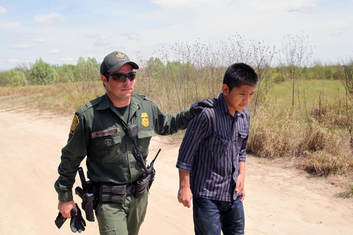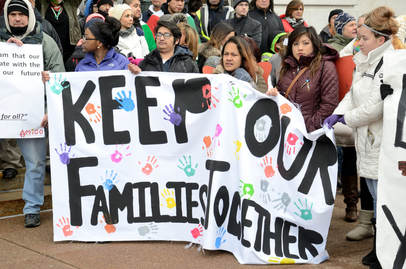"There can be no keener revelation of a society's soul than the way in which it treats its children."
— Nelson Mandela
Say No to Zero Tolerance
|
A major concept of the American Dream that drives many people to come to the United States is family. For generations, family values have greatly shaped our society. However, these values have been threatened at various times in our country's history, most recently in April 2018 when the Trump Administration signed an Executive Order that resulted in the separation of families who crossed the U.S. border in search of sanctuary. Due to this Executive Order, more than 2,000 children were separated from their parents. Although the family separation Executive Order, also known as "zero-tolerance", was rescinded two months later in June, the backlash of the policy continues today as hundreds of children continue to live in detention centers waiting to be reunited with their families.
In this lesson, you and your students will explore the complex push and pull factors that lead people to migrate to the U.S. for sanctuary. Furthermore, this module will show the negative implications of the family separation policy and how you and your students can make an impact. Since this topic is very sensitive and you may have students who relate to the different stories, it is important that you set ground rules for this lesson in order to have a healthy dialogue about this very controversial issue. Click here for helpful tips on "How to to talk about immigration in your classroom (or anywhere!)" from the American Friends Service Committee. |
Step 1: Hook
|
Give each student a country outside of the United States and a scenario that would lead a person or family to come to the United States. An example of a country and a scenario could be El Salvador, where people are leaving the country due to violence. You may also use stories from My Immigration Story to provide a wide range of immigrant narratives for your students. After the students have read and thought about the scenario, have them write an argument about why they deserve asylum and what qualities they can bring to the United States.
When students have finished writing their arguments, have them present in front of the class. Follow this activity with a discussion of how it may be difficult for people, especially children, to argue for themselves without a lawyer. |
Step 2: Videos and Teacher Resources
|
|
To follow the previous activity, have your students watch “UNACCOMPANIED: Alone in America” (4:17). This short film is a re-enactment of typical proceedings involving unaccompanied children that occur in immigration courtrooms daily. After watching this video, have the students discuss how they feel about seeing children having to defend themselves. Do they think it is easy? What would they do if they were in that situation?
Have your students explore www.theundocumented.com to help them better understand the path many of the families took to come to the U.S.. Students will be able to see the death toll on the border since 1981, as well as partake in an interactive stimulation that will introduce them to some of the dangers people crossing the border without papers have. Have the students think about why people risk their own lives to cross the border, even though it is extremely dangerous. In many cases, when the government creates or decides on certain policies, the psychological impact the policies may have are seldom put into question. To highlight the mental and emotional impact of the family separation policy, have your students watch how separation impacts the development (3:19) of a child short and long term. |
Step 3: Standards-Based Exercise
|
The legal and social terms surrounding the complex topic of immigration can sometimes be overwhelming. We have attached a list of vocabulary to help your students learn the different terms here. The Sydney Morning Herald YouTube channel has also put together the legal definitions of migrant, refugee, and asylum seeker (2:06) from the 1951 United Nations Convention Relating to the Status of Refugees. While using at least one word from the vocabulary list or from the migrant, refugee, and asylum seeker vocabulary, have your students write a letter to a child between the ages of 5 to 17 years that was separated from their parents. If you would like, the class can send letters to the address in the bottom of the article "How to send a letter to a child separated from their family at the border" here.
|
Step 4: What Can Students Do?
|
The nonprofit organization, American Civil Liberties Union (ACLU), has provided resources for you and your students to get involved and support the families that were separated. The ACLU’s call to action includes having your students call congress, listen to podcasts, print posters, and even start their own campaign.
Your class can also get involved by writing letters to children that are still in the detention centers here. Students can join the #postcards4families campaign by writing postcards to President Donald Trump urging him to bring families together. Students can volunteer locally, or use their social media platforms to raise awareness for others to volunteer. |
Additional Resources
|
AFT Resources
|





